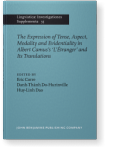Chapter 12
French tense challenged by Finnish aspects
This article calls into question, on the basis
of selected excerpts from the Finnish translation of Camus’ novel,
Sivullinen, two commonly held ideas: (1)
L’Étranger’s style is “oral”; (2) Finnic
languages have a poor TAM system – if only tenses are considered. Different from Perfekti, that conveys a past event with present relevance, the Finnish Imperfekti is the verbal form of narrative dynamism: Imperfekti allows the speaker to take a
stand as an observer of an action anchored in the past, it is
theoretically the perfect tense for Meursault’s Finnish account. But
the translator is confronted to a dilemma: in order to preserve the
naturality of such a typologically different language, should he
refrain from resorting to the multiple ressources of the Finnish
aspectual derivation system, and stick to the standardized register
of simple Imperfects? The restrictive temporality of Non-Finite
Constructions provides a compromise solution.
Article outline
- 1.L’Étranger’s temporality: pc vs. ps
- 2.Orality of L’Étranger as a discourse
- 2.1Impromptu speech vs. Simulated
speech
- 2.2Information structuring: The oral–written relationship
- 2.3Oral features in L’Étranger?
- 3.Finnish, a North-Western Uralic language
- 3.1Typology of Finnic languages
- 3.2Finnish verb: Tenses and aspects
- 3.2.1Finnish past tenses
- Summary: Difference Imperfekti / Perfekti
- 3.2.2The Finnish TAM system
- 4.L’Étranger / Sivullinen: Passé composé / Imparfait vs. Perfekti /
Imperfekti?
- 4.1Finnish aspect and resultativity
- 4.1.1Verb derivations
- 4.1.2Object case alternation
- 4.2Non-Finite Constructions (nfcs) and
temporality
- 5.Final conclusion
-
Notes
-
Glossary
-
References
